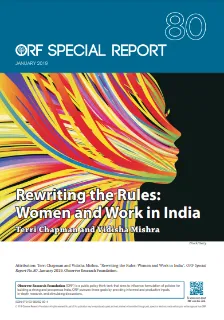Introduction
India has made significant economic progress in recent decades, including increasing GDP per capita from US$375 to US$1,572 between 1990 and 2015. Such economic growth, however, has not been matched by progress towards women’s equal economic participation. The country’s female labour force participation rate (FLFPR) stands at just 27 percent, compared to 96 percent for men. Methodological differences have resulted in varied estimates by different sources, including government agencies and academic researchers. Even so, given the global average of 49 percent, women’s under-participation in the Indian workforce is evident.
Current research reveals four primary factors that help explain India’s low—and potentially declining—FLFP rate: 1) the pervasiveness of entrenched patriarchal social norms that hinder women’s agency, mobility and freedom to work; 2) rising household incomes that create a disincentive for labour market participation among women mainly informed by the same norms in (1); 3) the disproportionate burden of unpaid work and unpaid care work on women; and 4) the lack of quality jobs for women reinforced by gendered occupational segregation and a significant gender wage gap.
Women’s access to decent paid work is an undisputed ethical and economic imperative as well as a primary human right and aspiration. It is clear that the current under-participation of women in paid employment in India is not due to their lack of will. More than a third of Indian women (both urban and rural) primarily engaged in housework report wanting to work for pay if a job were available. Indeed, the participation of educated, capable women in the workforce makes for a strong economic argument: the International Monetary Fund (IMF) finds that India’s GDP will increase by as much as 27 percent if women participated in the economy at the same rate as men.
Emerging technologies and digitisation are transforming work in India. Labour relations, workplaces, industries and jobs themselves are being recast in the context of rapid technological adoption. It is within this context that existing gender disparities can either be reduced, or exacerbated.As the organisation of work changes in India, there is an opportunity and need to redefine the social norms that govern women’s economic participation. This report sets forth a new normative framework that rewrites the existing norms that systematically keep women out of the workforce. Taking women’s under-participation in the workforce in India as an established starting point, this report offers six new norms for redefining the rules governing women’s economic participation.
1. Redistribution of Responsibility
On average, 66 percent of the work done by Indian women is unpaid, compared to 12 percent of men’s. This is a global pattern, as women in other parts of the world are disproportionately burdened with unpaid work and care work. In India, according to the OECD, women spend on average 352 minutes a day on unpaid work against 52 minutes among men. With regard to unpaid care work, women in India spend on average 297 minutes a day on tasks such as taking care of children, the elderly and the sick; in comparison, men spend 31 minutes a day.
This is relevant as research has established an inverse relationship between the amount of time spent by women and girls on unpaid work, and their economic autonomy. For instance, findings from a 2018 survey reveal that girls’ housework and domestic responsibilities contribute to a gender gap in secondary education. At the same time, over 40 percent of surveyed men report feeling that married women whose husbands earn a decent living should not work outside the home. The perception that women should not leave the private sphere in the absence of monetary need reinforces the burden of unpaid work.
India’s Amended Maternity Benefit Actstipulates that employers must provide women with 26 weeks of paid time off. Given the absence of a corresponding benefit for new fathers, it perpetuates the gender stereotype of women being the primary caregivers. The law also covers only formal and large-sized firms which, overall, employ only a small proportion of the country’s female workers.
It is clear that the additional disadvantages that working mothers face vis a vis working fathers and childless individuals account for a sizeable share of the gender wage gap as well as disparity in promotions at work. Equally, it is clear that simply institutionalising voluntary paternity leave and ‘flexi-time’ for mothers remain inadequate. For example, new fathers opt against taking paid time off due to the fear of lagging behind their work responsibilities Therefore, innovative policies are required to incentivise more active sharing of caregiving responsibilities and in the long-term, changing the overall organisational culture to reverse what is known as “motherhood penalty”. For instance, companies could support the return of working mothers into the workforce, by paying more to fathers/other parents for taking over the caregiving responsibilities.
New norm: De-feminisation of unpaid work and caregiving.
Corollary: Social, political, and economic incentives must allow for the redistribution of unpaid work and care work.
2. New Social Protections for A New World of Work
More than half (51 percent) of India’s workforce is self-employed, compared to 33.5 percent who are casual labourers and just 15.6 percent who are regular, salaried workers.[xxiv] This means that the vast majority of workers are not covered by the nation’s labour regulations.[xxv] A significantly higher number of women in India work in the informal economy compared to the formal sector.[xxvi] For instance, in the largely unregulated domestic work sector, there are 2.3 million women domestic workers out of the 3.9 million domestic workers in India.[xxvii] At the same time, countries including India are seeing a rise in non-standard forms of work such as platform work, the gig economy, temporary work and independent contracting. While these new forms and formats of work offer advantages such as easier and cheaper access, lower transaction costs, flexibility, and reduced barriers to entry, in most cases these workers lose out on the social security, benefits and protections afforded to those employed in permanent jobs. [xxviii] India will need to find ways of both meeting existing gaps in social security and protections, and creating new social safety nets that account for the needs of workers engaged in new forms of work. One means of achieving this is to link protections directly to individuals rather than providing them through employers. This will require a re-imagination of social security provision mechanisms, as the employer-employee relationship becomes less prominent. New norm: Social security and protections must be delinked from employment and linked to the individual to be portable in an independent, informal, and increasingly digital workforce. Corollary: Healthcare, pensions, and insurance must be portable and aggregatable across the new workplace and designed based on the employment circumstances.
3. The Future Work Space
The Sexual Harassment of Women at Workplace (Prevention, Prohibition and Redressal) Act 2013 is a positive step towards addressing harassment at work. Yet, 84 percent of companies surveyed in 2018 by the Observer Research Foundation (ORF) and World Economic Forum (WEF) report being unaware of the policy.
Guaranteeing women’s right to a safe and equitable working environment becomes more important in intermediate spaces. That is, the premise-based nature of protections means that the many freelancers and platform workers that work in co-working or public spaces are not covered. The responsibility for underwriting the security and wellbeing of workers must be reconsidered.
Safety, in general, remains a key concern in India and the perception of danger reinforces the social norms that restrict women’s mobility. Pande (2018) found that 80 percent of women in India need permission from their husband or other family members to visit a health centre.The twin realities and perceptions of danger are manifested in ways that constrain women’s movement and freedom. This has direct implications for women’s economic participation and freedom.
New norm: All workspaces are safe, gender-inclusive and non-discriminatory.
Corollary: As work becomes more fluid and traditional conception of workplaces changes, individuals must be ensured protection at their place of work rather than place of employment.
4. Women Excel in all Industries and Occupations
Female labour force participation in India is concentrated in a small number of industries including education, textiles, health and social work. These are also industries with low average wages. In contrast, women’s participation in the industries with the highest average wages (including information and communications and financial services) stands at a low 15 percent. Eight times more men work in high-skilled jobs than women. Women are three times more likely than men to be family workers.
There is a widespread perception that female labour force participation has been increasing in recent years, a period for which reliable data is not available. The ORF-WEF 2018 research reveals that 36 percent of surveyed companies are not looking to hire more female workers because they prefer male employees. The combined challenges of occupational segregation, a skewed distribution of high-skilled male workers, and a lack of will among Indian firms to hire more women workers concurrently define the challenge ahead.
Gender segregation is equally apparent in education and skills – boys and girls are differentially encouraged to take up certain subjects. As the digital economy grows, and new jobs requiring new skills emerge, women and girls will be left behind without concentrated investments in increasing their education in future-proof industries and occupations.
Current literature identifies the reasons for the skills gap:
- Sociocultural: Aspirations are shaped by socio-cultural norms and perceptions about what a woman can and should do.
- Informational: Men and women do not have access to the same amount of information and opportunities pertaining to education, skills, and jobs that have been traditionally male-dominated.
- Institutional: Factors such as time constraints, safety and transportation considerations that hinder women’s entry and progress in training programs and jobs are not adequately addressed.
New Norm: Policies and incentives must catalyse women’s equal participation across all jobs and sectors traditionally seen as male bastions.
Corollary: The government, private sector, communities, and families must rethink the design and delivery of skills and education programmes that will allow women’s participation and rise across existing and emerging industries and occupations.
5. Reducing the Wage Gap
India has a gender wage gap of 34 percent, despite the existence of India’s Equal Remuneration Act 1976 which mandates equal pay for the same or similar work and bars discrimination in hiring. Further, the pay gap increases with age, work experience, and rise in occupational hierarchy – thus disincentivising the women to stay on.
Despite having legislation similar to India’s, no country has been successful in fully eradicating the gender pay gap, although some have narrowed it considerably. For instance, in 2018, Iceland became the first country in the world to mandate companies to prove that they do not have a gender and ethnicity-based pay gap. Under the Equal Pay Standard legislation, companies with over 25 employees must have their accounts audited every three years to obtain a government certification. While more regulation could seem daunting, in the absence of an organic progress in eradicating the gender pay gap, this is a legitimate solution.
Moreover, evidence suggests that the emerging gig economy could replicate the wage gap. Evidence from a million rideshare drivers on Uber, estimated that on average, men earn seven percent more than women A study on freelancing work in India found that highly experienced freelancing males make on average 50 percent more than their female counterparts. Therefore, the structures that influence existing issues such as the gender pay gap, gender-based occupational segregation, and biases in hiring are not being addressed – these very same issues are likely to be replicated in the digital and gig economy.
New norm: Equal compensation for equal work.
Corollary: Legislate equal compensation, and gender performance of organisations must be subject to audits and public scrutiny.
6. Women-led Growth for an Inclusive Future
There are enough examples to show how vital products, services, and facilities have traditionally been designed by and for men. Seatbelts, for example, have been proven to be less safe for women as crash-test dummies were designed after men; female drivers are said to be 47 percent more likely to be seriously injured in a car crash. Medicines, too, are tested predominantly on males despite evidence that women and men differ in their risk to, and response to medical conditions. The default, therefore, has been male, and this bias is structurally built-into people’s daily lives.
At the same time, the female consumer has never been considered a growth market beyond cosmetics, even as companies are now acknowledging the rising ‘she-conomy’. As women represent the largest emerging global market segment and economy, there is an opportunity to correct the status quo if industries are female-driven and designs are diversity-oriented. At present, only 14 percent of businesses in India are run by women. The lack of access to formal and collateral financing, reinforced by cultural bias has been found to be the major obstacle for women entrepreneurs in India. The recent establishment of NITI Aayog’s Women Entrepreneurship Platform (WEP) is a step in the right direction.
In addition, women comprise only 12 percent of the members of the national parliament. Interventions to aggressively promote women in leadership positions are equally necessary to enable the other norms. However, while having a discernible number of women in leadership positions creates a critical mass and perhaps a collective voice, promoting women’s leadership must not be reduced to affirmative action alone. The roles of social networks and social capital deserve serious consideration in society, where power is not exercised through institutions and laws alone.
Further, the migration of economic work from in-person to peer-to-peer tech-enabled platforms makes it critical to explore how gender dimensions come into play not only when women are workers, but also when they are employers.
New norm: Women-led markets – women-led products, services, and solutions.
Corollary: Growth models led by women must define the fourth industrial revolution.
Conclusion
While there are several factors that hamper the full economic participation of India’s women, it is clear that most of them can be traced back to entrenched social norms that restrict their agency and, consequently, their full participation in the economy. It is also clear that for technology to be empowering, prevailing socio-cultural norms must be addressed. The gender gap in education and skills, the burden of unpaid work, and lack of safety and freedom of mobility negatively influence women’s digital, financial and labour market inclusion.
Current trends show that gender-neutral policies do not lead to gender-equal outcomes. Therefore, policy interventions aimed at increasing female labour force participation must acknowledge the pervasiveness of gender stereotypes that lead to occupational segregation, the unequal learning and skills-development opportunities for boys and girls, and women’s informal and unpaid work. Further, there is a need for India to find ways to recognise and institutionalise sharing of care work between men and women, to reduce the gender wage gap, and aggressively work towards creating a violence-free, level playing field for its women to thrive and become leaders in the economy.
Endnotes
The views expressed above belong to the author(s). ORF research and analyses now available on Telegram! Click here to access our curated content — blogs, longforms and interviews.

 PDF Download
PDF Download



 PREV
PREV



